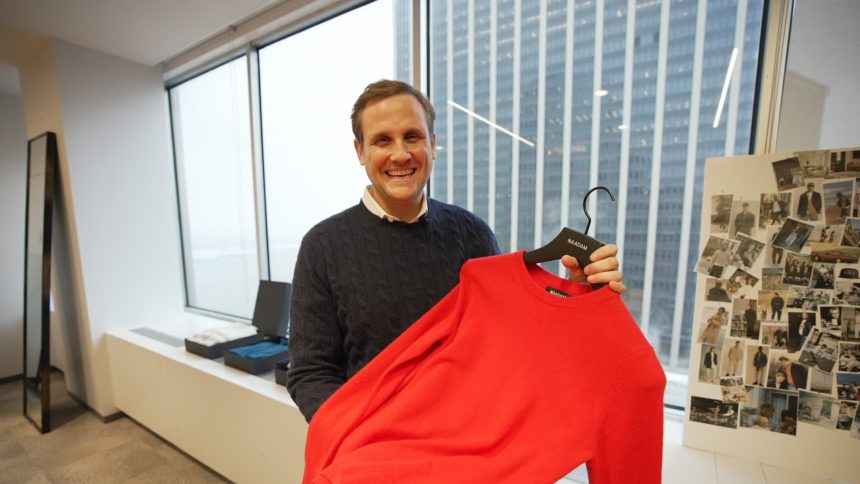The story of Matt Scanlan, Diederik Rijsemus and cashmere apparel brand Naadam reads like an adventure novel.
During a globetrotting vacation in 2013, the two college friends found themselves stranded among Mongolian goat herders in the Gobi Desert for three weeks. They learned about the wool trade, and came away with a business idea: Make low-priced cashmere goods by purchasing wool directly from those herders, skipping the middlemen who bought low and sold to apparel brands at a high markup.
Neither co-founder had any industry experience or enough money to fund a startup. But in 2015, Scanlan’s parents put up their home as collateral for a $2.5 million loan from a private lender. Scanlan and Rijsemus transferred it to a Mongolian bank, withdrew all of it and drove the cash — stuffed into 32 plastic shopping bags, filling the back of an SUV — deep into the desert to buy Naadam’s first 50 tons of unprocessed cashmere wool.
In 2022, Naadam brought in $100 million in total revenue selling a wide range of cashmere products, from its top-selling $98 sweater to sweatpants and tank tops. (The business declined to share its 2023 sales numbers before the close of its current fiscal year.) It sells online, in stores like Saks 5th Avenue and in three of its own New York and Los Angeles brick-and-mortar locations.
Scanlan, the company’s CEO, is well aware how insane that sequence of events likely sounds. Given the inherent risk of a desert shopping spree with borrowed money and the fact that he’d never run a company before, he says “there were many moments” early on when he “had no idea how we were going to pay back that loan.”
Here’s how Naadam defied the odds.
‘A little bit of luck and opportunity’
First, Scanlan and Rijsemus obtained the wool. Then, they needed to figure out what to do with it.
They sent it to Beijing, where it was cleaned and scoured for impurities. From there, it went to Italy, where another third party spun it into yarn. The co-founders sold most of that yarn to pay off their loan, and used the leftovers to make sweaters, says Scanlan.
Scanlan loaded the sweaters into a car for an east coast sales trip, pitching “every store I could” between Maine and Charleston, South Carolina, he says. “I’d pull the sweaters out on the table and I’d lay them out neat and I’d tell my story. We had 50 orders, each one like $1,000, and I learned how to perfect my story … I didn’t realize at the time that I’d be doing that for the rest of my life.”
Simple as it sounds, the business grew from there. In 2018, Naadam posted a three-minute video online detailing the co-founders’ early desert exploits and their vision for the company. It’s been viewed more than 35 million times since then.
“That video defined Naadam’s success for a long, long time,” Scanlan says. “It probably is still the best advertisement we have for who we are and what we’re about.”
Along the way, Naadam picked up more funding: over $50 million from investors like private equity firm Vanterra Capital, according to Scanlan. None of it could’ve happened without a lot of luck, he notes — including his parents’ willingness to put their home up as collateral for a business that had no guarantee of succeeding.
“You can have a great business plan, but if you don’t have a little bit of luck and opportunity on your side, it kind of doesn’t matter,” Scanlan says. “Every major inflection point that we’ve had along the way … we’re just [at] the right time, right place.”
A good story only gets you so far
Companies also need profitable economics to stay alive. Naadam only exists because of the cashmere industry’s middlemen, who buy goods from remote farmers at low prices and profit by reselling up the chain, resulting in the sort of exorbitant costs typically associated with the fabric, says Scanlan.
“[The goat herders’] remoteness led to, essentially, fixed pricing strategies that meant they couldn’t negotiate up the value of their raw material effectively,” he says.
He and Rijsemus reasoned they could pay the herders double what they typically received for their wool and still pass on considerable savings to consumers. Naadam’s most popular cashmere sweater costs $98. Comparable sweaters often cost hundreds of dollars, or even more than $1,000 for luxury brands.
Naadam also offers more expensive options, like a cashmere coat that costs nearly $700.
But reasonable prices and an entertaining story only get you so far. Clothes that look ugly or fall apart at the seams wouldn’t sell, no matter how cheaply you price them, says Scanlan: “All that work, [from] being in Mongolia to getting you that product, [would be] for nothing.”
A Wirecutter review of Naadam’s $98 sweater, most recently updated in December 2023, says it does develop some fuzz over time, but its quality “rivals that of sweaters costing twice as much.”
“I need to make sure that that product is amazing, and you get it, and you go, ‘I’m going to tell everyone I know about this, and I want ten more of these, and I want every single color,'” Scanlan says. “That’s how we make money.”
Want to land your dream job in 2024? Take CNBC’s new online course How to Ace Your Job Interview to learn what hiring managers are really looking for, body language techniques, what to say and not to say, and the best way to talk about pay. CNBC Make It readers can save 25% with discount code 25OFF.
Plus, sign up for CNBC Make It’s newsletter to get tips and tricks for success at work, with money and in life.
Read the full article here




